The attorney’s guide for transitioning to a paperless law office

Co-founder & COO of evident

Co-founder & CEO of evident
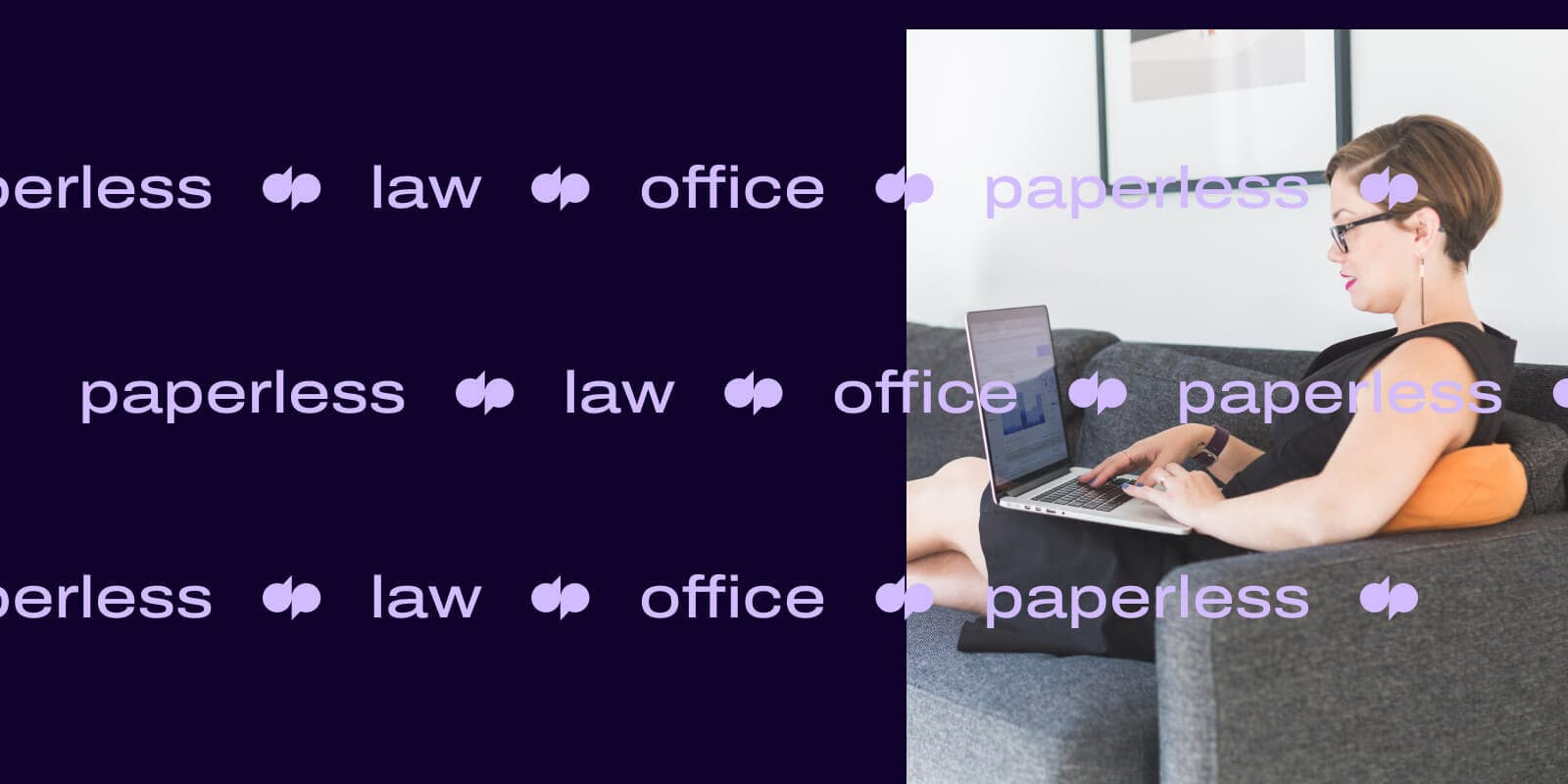
Tags
Share
If you were asked to picture a law office right now, your mind would probably go to one of two places: the sleek, modern offices that everyone in Suits spends most of their time in, or a cluttered space full of piles of paper documents and bookshelves lined with binders packed with even more paper.
Most lawyers probably want their office to look like the ones in Suits. But realistically, how does that happen?
Even the world’s best document management system can’t keep every piece of paper in the right place one hundred percent of the time, after all.
But that’s just the thing: The paper itself is the problem. To get that elegant, organized, well-maintained law office, there’s one route you can take.
You can go paperless.
In this guide, we’ll break down how you can do that, step by step.
What is a paperless law office?
Before we dive deeper into what it means to go paperless, let’s consider what any modern or virtual law firm has to contend with.
For starters, there’s a lot of paperwork involved in the world of law. First-time clients will already necessarily bring new documents with them, and then there are repeat clients’ files that are full of details about every interaction the law practice has ever had with those clients.
Needless to say, document management is both crucial and difficult at any law office.
That brings us back around to the idea of adopting a paperless system.
A paperless law office, simply put, is a legal practice that keeps minimal, if any, paper copies of their documents to hand.
Instead of printing every document, paperless law firms convert their paper files into digital documents. These electronic files are then used in the place of printed copies. That also means that anytime a client requests a contract or similar legal document, a paperless firm would send it to them in the form of an electronic document, not a printed one.
While the concept of a paperless office has become more appealing since COVID-19 pushed more people into working from home, the ABA (American Bar Association) has been discussing them since 2019—a full year before the start of the pandemic.
Is going paperless even possible in the legal world?
Essentially, yes, it’s possible to go paperless as a legal firm. The fact that around one-third of all the firms in a recent survey handled their document management using a cloud-based model—in other words, paperlessly—already goes a long way to indicate as much:
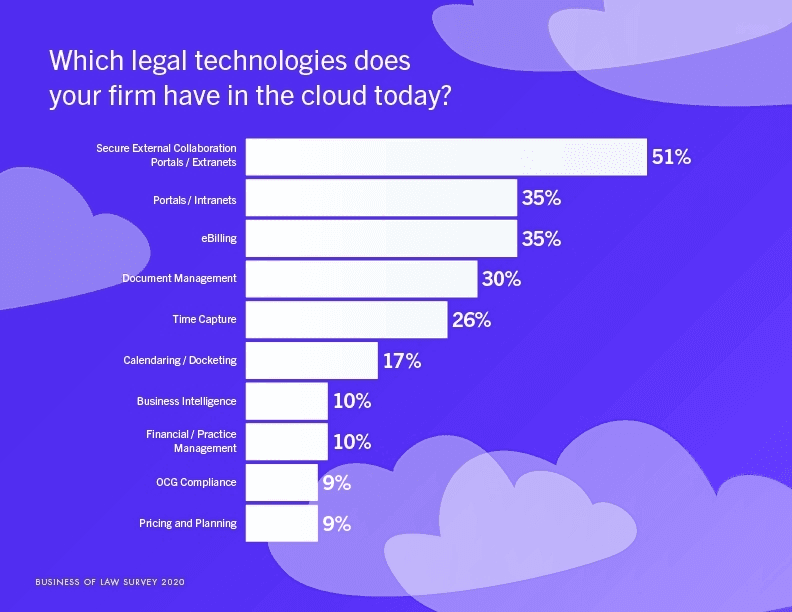
If your firm is already digitizing its legal practice management or document management, you’re already likely using significantly less paper than your competitors, and much closer to going totally paperless.
Some things cannot be done using digital files, of course. In states like New York, certain documents need to be signed using “wet signatures,” and this needs to be taken into consideration during the digitizing process, since not everything can be turned into a paperless workflow.
At the same time, most workflows can be digitized, and a paperless law office is entirely realistic.
The 2 main risks of not going paperless
Before we consider how a paperless practice management system can benefit your firm, let’s look at two risks of not going paperless.
Misplaced documents
As we’ve established already, lawyers deal with a lot of paperwork on a daily basis and need an incredibly well-organized filing system to prevent files from getting lost.
The truth is, misplaced documents can still be a problem even with a pristinely organized storage space and an ideal storage system that dictates where each document has to go. Things go missing all the time.
Natural disasters
Unfortunately, any practice area can be struck by natural disasters. Hurricanes, floods, fires, and other disasters have the potential to do devastating damage, particularly if all your important documents only exist in printed form.
At best, you’d have to dig through rubble for those crucial pieces of paper. At worst, they’re gone forever. Documents in cloud storage, on the other hand, cannot get soaked or physically destroyed.
Paper documents just don’t provide that level of peace of mind.
The benefits of a paperless law firm
It’s a time, money, and space saver
When all your documents are digital, you don’t have to rent out extra space just to fill it with filing cabinets. That means you get to save both money and space, as well as time that would otherwise be spent searching through those cabinets for that one elusive document.
One important thing to note is that even in a, say, 90% paperless law office, you’ll still need a printer. That being said, you can still save quite a bit on printing costs, and by reducing your paper document volume, you can reduce the amount of money you spend on ink or on repairing printers when they break or need maintenance work.
(This is especially important to small law firms, which typically have a tighter budget.)
Paperless practice management software also usually comes with a built-in search function. That’s a guaranteed time-saver. All you need to do is enter a keyword, and all relevant documents will appear right away without any need to go looking for them manually.
It can help improve firm security
It’s impossible to encrypt or password protect physical documents. Digital files, on the other hand, can be locked behind multiple layers of security that’s compliant with all safety regulations.
Instead of having to rely on a locked door to do its job, you can rest easy knowing you can trust in your chosen software platform to keep all your data secure.
👉 Dialpad tip:
Encryption keeps all your sensitive information safe, even in the unlikely event that a hacker manages to get access to it. With a UCaaS solution like Dialpad, you can encrypt your documents, messages, and even phone calls to make sure that only the intended recipients can access any potentially sensitive discussions.
It increases productivity and efficiency
It’s far easier to be productive when you can quickly find any resources and documents you might need to finish a task. And, searching for virtual files is far quicker than searching for physical ones.
This applies doubly to remote work environments—which, as of 2020, includes the vast majority of law offices:
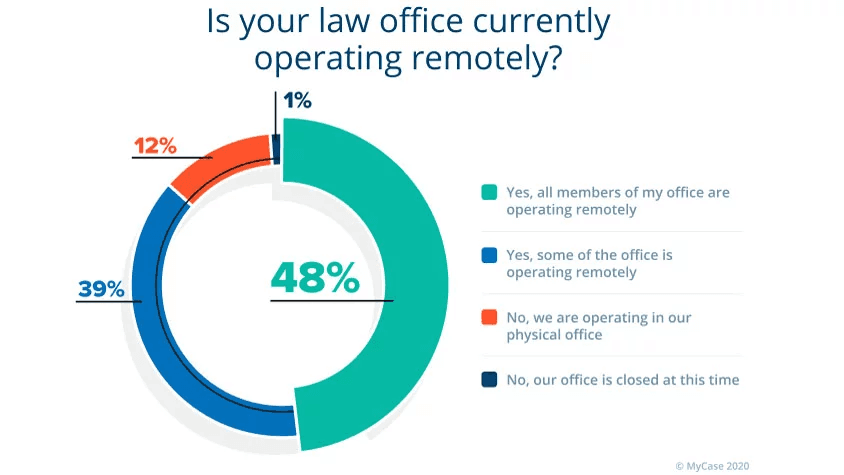
When some or all of your office is working remotely, it makes a lot of sense to go with cloud-based solutions because they can help you go paperless.
Using cloud-based software in this way also makes it far simpler to work across time zones and serve clients from anywhere in the world. And while this alone won't solve the attorney burnout problem, it can go a long way in helping mitigate it.
It helps you provide a better client experience
With a well-managed paperless office, you never have to keep clients waiting while you search for their files ever again. All you’ve got to do is enter their name or file number into the search bar and all your documents related to them will instantly be at your fingertips.
It’s good for the environment!
While this likely won’t be the main reason why most law firms go paperless, it’s a great ancillary benefit nonetheless.
When you go paperless, you dramatically reduce the amount of paper you use. Paperless firms don’t have to print extra copies for clients, replacements for lost copies, or extra copies for multiple locations.
(As an added bonus, you don’t have to think twice about making a new document for any reason.)
What you need to transition to a paperless law office: 3 main things to consider
Of course, the transition to a paperless law office doesn’t happen on its own. You’ll need to take the items below into account to make the switch happen, and to ensure that it goes as seamlessly as possible.
Team buy-in and habit changing
It’s never a good idea to suddenly spring new ideas on your team without giving them time to prepare. In this case, going paperless would affect practically every daily workflow in a law firm, so it’s especially important to get your team’s buy-in before you implement this big change.
Your attorneys’ and office staff’s day-to-day work habits have to be adjusted to accommodate a paperless work model, and the more time you give them to work on adjusting those habits, the easier the transition will be for them. (And the less likely you are to have trouble on the buy-in front.)
The right hardware and equipment
If you’re going to make the move to a paperless office, it’s worth your while to make sure that your computers, webcams, mics, and so on are up to par.
Good equipment is becoming increasingly important to running an office effectively. At the same time, legal firms are facing increasing expectations to use good in-house technology:
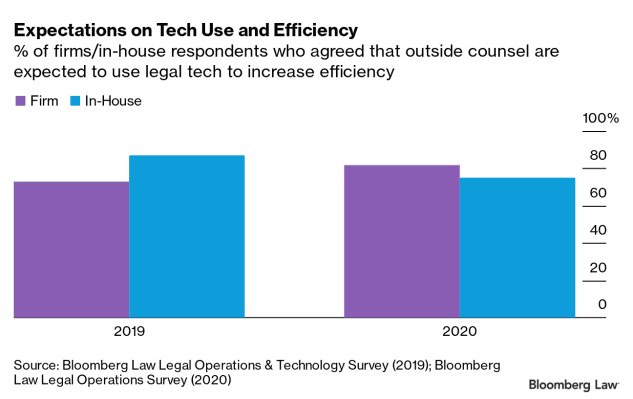
Of course, when your business management model relies on using tech to house all your documents, it does follow logically that you’d want that tech to be top-of-the-line. So, which pieces of technology should you focus on?
Here are four to consider.
Computer monitor
You’ll be dealing with a huge amount of digital documents, and those need a monitor to be displayed on.
The right monitor will have good resolution so that every document is crisp and clear regardless of whether it was scanned in or generated in Adobe Acrobat. It should also have adjustable brightness and glare levels. If you’re going to spend hours every day reading documents, this is one of the biggest ways to save your eyes.
All of your employees will need a monitor. Some may even need two, depending on their roles and workloads. It’s well worth it to check for this in advance, so you can budget more easily.
Tablet
Tablets are a good option for on-the-go work if you’re looking for something that’s lighter than a laptop, especially when it comes to meeting clients.
You can also use them at your firm’s reception desk to allow clients and visitors to check in for appointments with attorneys and staff.
Scanner
Before you make the switch, you’ll have anywhere between a few folders’ and a few full filing cabinets’ worth of documents. Those need to be digitized, and what better way to get that done than with a scanner?
Which scanner you choose depends on a few factors. Most importantly, you need to consider how much paper it is that you’ll be scanning.
If your law office is quite new, you might not have as much paperwork to digitize. If it’s a few years old already, you’ll want whichever scanner gets things done the fastest so you can work through that backlog more quickly.
Paper shredder
You’ll be scanning and digitizing your files, so what happens to the leftover sheets of paper once that process is complete?
The answer is simple: Those documents that don’t need to be kept in original form get shredded, and it’s an essential step to going paperless. You’ve got to get rid of your paper first!
Software to address communications, file management, and more
Now, let’s look at the legal apps and technology that’ll help make work life easier.
CRM
A CRM, or customer relationship management tool, is important to any modern business that wants to keep its clients happy and improve engagement and retention.
From Salesforce to HubSpot to Zoho CRM, there is a range of CRMs that a law firm can use to keep track of its client relationships. (Interested in how AI plays into this? Learn more about AI for lawyers in this guide.)
If you can, try to choose a CRM that integrates with your other tools like your law office phone system or communications platform. For example, Dialpad integrates with Salesforce to automatically log activities to contact records and even embed a CTI dialer right inside Salesforce so that you don’t have to toggle back and forth to make a phone call:

Virtual fax
Going paperless doesn’t mean sacrificing the ability to fax. All you’ve got to do is get your law office set up with virtual fax software, so you can still fax the kinds of documents you’re used to faxing without having to print them out first.
A virtual fax can be signed digitally as well, making this an ideal solution for paperless law firms that often need to obtain client signatures.
Cloud storage
Putting your documents into cloud storage gives you easy access to them, and ensures secure storage as an added bonus. Most modern cloud storage solutions are outfitted with tough security functionality, as well as encryption as a backup safety measure.
Two of the most popular cloud storage solutions today are Google Drive and Dropbox. Both offer a free version of their software with limited storage capacity, so you can try them out and see which one is a better fit for your practice.
Google Drive
All you need is a Google account, and you can access Drive from anywhere. You can upload standard files (.doc, .docx, .xls, .pdf, .ppt, and all major image file types, among others) for quick access. You can also use Google Docs, Google Slides, Google Sheets, and others to create files within your Drive.
A major advantage of Google Drive is that unlimited users can be shared into any given document. That means that you can create a Google Doc, share it with everyone in the office, and then work collaboratively in that document with colleagues all over the world.
It also offers flexible pricing options to suit any size of business, ranging from $5 to $15 per user per month.
Dropbox
Dropbox places a bigger emphasis on storing and sending large files. It doesn’t come with built-in Google Docs functions, but it does come with safer encryption than Google Drive. It’s also faster at syncing your files than Drive.
There are two pricing tiers available to Dropbox users: $9.99 per month or $19.99 per month.
Case management software
Every law firm will have at least a few cases to track at any given time. That means that every law firm can benefit from case management software like Clio and Practice Panther, both of which help keep your cases organized and on track.
Clio
With Clio, it’s easy to log the time spent on each case and manage billing and documents. In fact, it boosts efficiency to the point of helping law firms get paid more quickly. In many cases, on the same day that they billed clients:
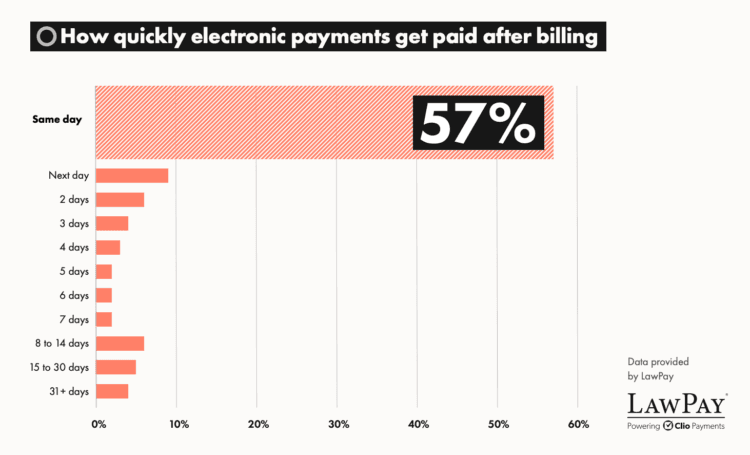
Clio streamlines processes that would otherwise be time-consuming and potentially expensive. With its Dialpad integration, Clio lets you transform your call and time tracking for the better as well.
It helps you run your law firm more efficiently, which is doubly true if you make use of its built-in file storage system. That way, you can access, manage, and process your documents from the comfort of one unified app that’s also mobile-compatible.
Practice Panther
PracticePanther’s software platform exists to help you automate the work of your law firm so that any daily process is more streamlined.
It makes the billing process significantly easier by offering lots of different pricing models for your team to choose from. That means your clients will be billed correctly and promptly each time they need to be.
Their prices range from $39 per month to $79 per month, the latter being aimed at larger-scale businesses.
There are other great case management solutions in the market as well, including MyCase and Smokeball.
8 best practices for running a paperless law firm
There are a few things to keep in mind if you go paperless that you wouldn’t need to consider as a paper firm. Here are some tips and best practices to help you get your paperless journey started on the right foot.
1. Scan existing and new paper documents as needed
This is why a scanner is one of the essential items you’ll need to make the switch to paperless. First, you’ll want to digitize your existing paper documents according to a clear system. (Are you starting with the most recent or the oldest documents? Or are you going alphabetically?)
Even after your existing documents have been scanned, your partners or clients might still use paper. It’s a good idea to have a process for scanning and filing in place that everyone follows when a new document is brought to the office.
2. Make sure your digital files are searchable
Keyword searching is one of the biggest advantages of going paperless, so it’s a good idea to ensure you’re capitalizing on that advantage. Choosing your file types carefully is a good way to get there.
For example, Adobe Acrobat lets you create PDF files that are fully word searchable. While Adobe Acrobat allows you to create fully word-searchable PDFs, you can take it a step further by using apps that transforms those PDFs into shareable links. This not only makes the content easily searchable but also instantly accessible across devices without the need to download files
That’s why PDF types are the most popular type of digital document in Google’s search results:
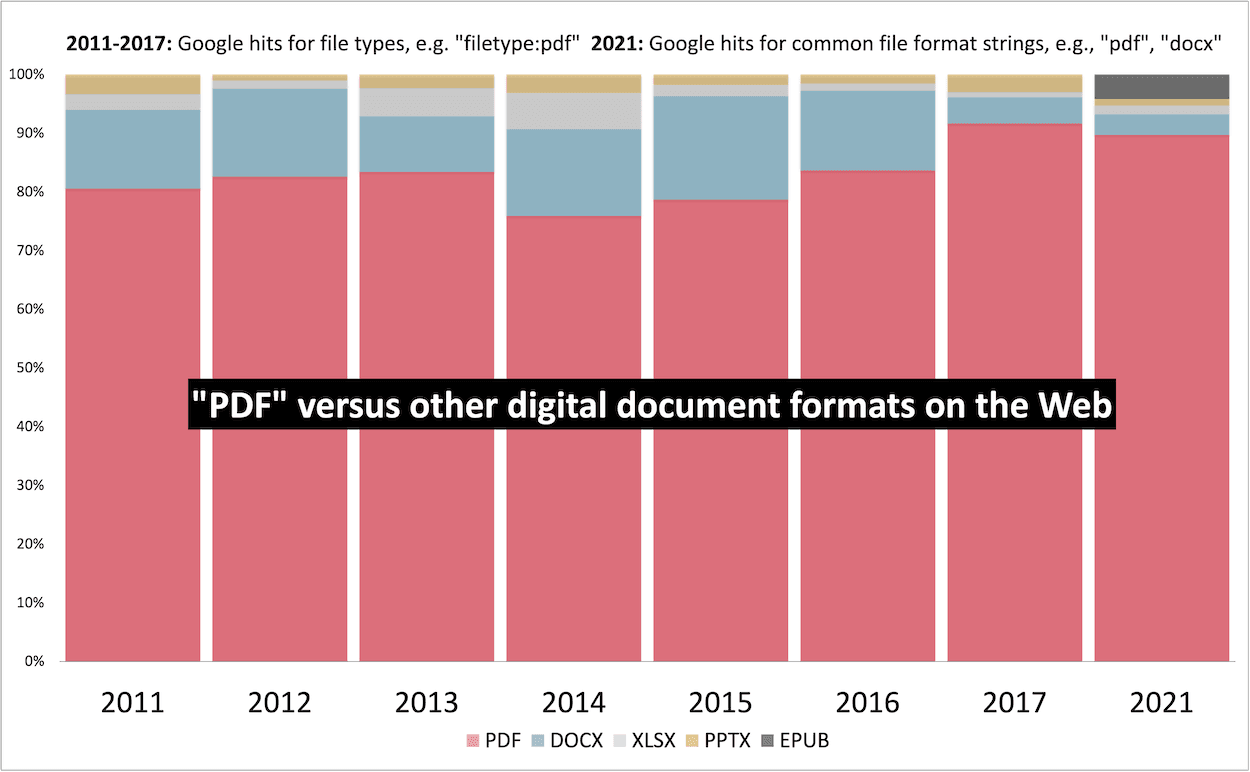
3. Keep only legally obliged documents in paper form
We’ve mentioned that some states have a need for “wet signatures” on certain types of documents, so that’s something to keep in mind. If your practice area includes one or more of those states, you’d need to keep some documents in paper form.
There’s no use in hanging on to paper copies that could be digitized, though. In other words, shred everything you don’t outright need, and keep the rest.
As a bonus, this makes it far easier to find the paper documents that you do need, because there will barely be any to sort through.
4. Have a data security plan in place
Data security is absolutely paramount, so don’t skip this step.
Before you commit to a particular piece of software, ensure you familiarize yourself with their data security protocols. It’s a good idea to get in touch with providers if you aren’t sure whether their security covers your needs.
👉 Dialpad tip:
Ensure all your software is compliant with standardized data protection initiatives, such as CSA, GDPR, and SOC2 for maximum security.
5. Keep digital files organized
It’s much easier to organize digital files than physical ones, in equal parts because of the search function and the naming and filing systems you can choose to use.
Naming system
Ensure you follow one set of rules for all your file naming so that every document is easily searchable.
For example, you could include the date and client’s surname in each file name.
Filing system
This is where you can make liberal use of folders and subfolders to keep everything as organized as possible. Whichever filing system you use, ensure that any given document can only be put into one specific subfolder so it’s easy to find items.
6. Turn to paperless file intake
Asking your clients and partners to send documents virtually can be a lifesaver.
This also means asking clients for e-signatures instead of wet ones—and as a bonus, you get to reap all the benefits that come with e-signatures:
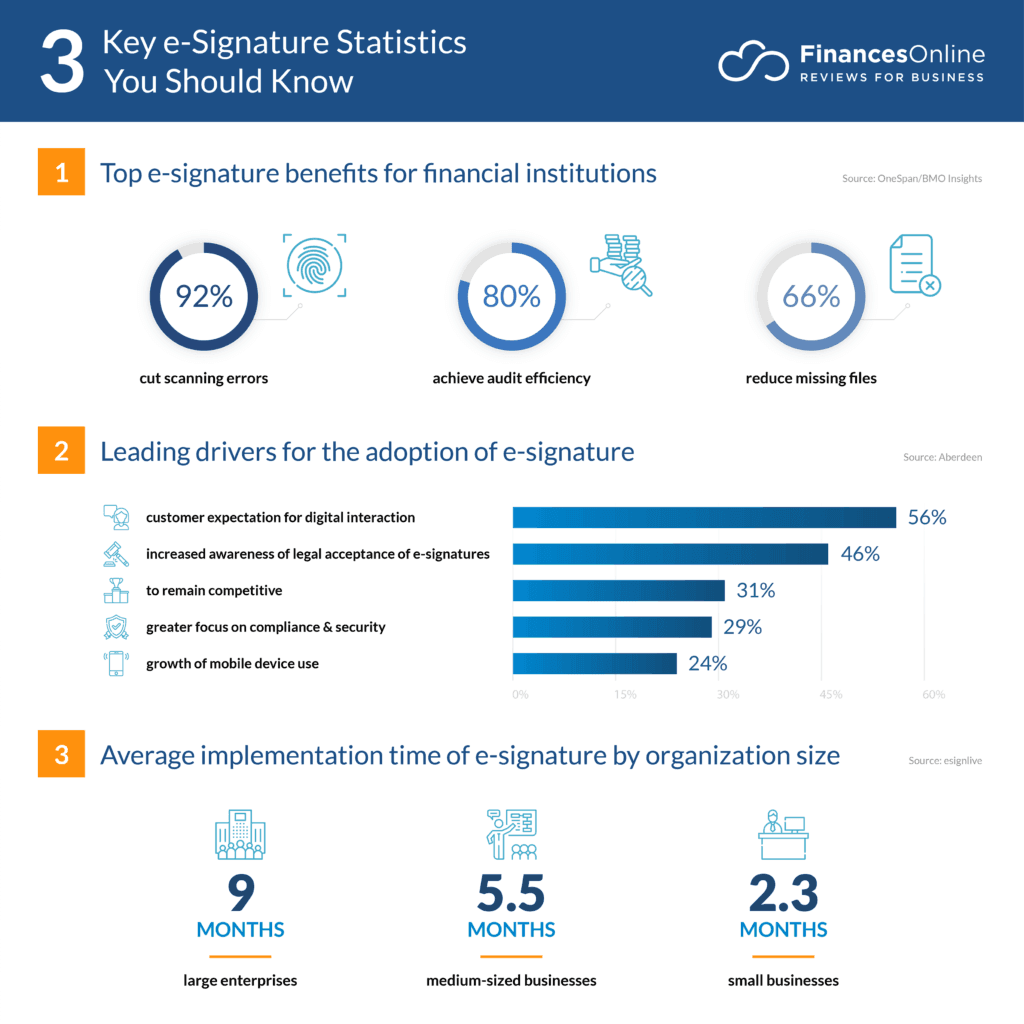
7. Have proper onboarding and training for paperless processes
The more your employees know about how to properly handle paperless processes, the lower the chance for paper copies to wind up getting printed.
In other words, teaching your employees about your paperless procedures and workflows during onboarding will save you paper and effort later on.
8. Keep all files appropriately accessible to those involved
Paperless documents are meant to be easily accessible to the right users. If you put in the effort to ensure that the right people have access to the right documents, that accessibility becomes a massive asset.
Of course, not everyone needs access to every file. Ensure your sharing settings are properly calibrated to make each folder accessible to the appropriate users.
Simplify filing and processing files with a paperless law office
Going paperless streamlines the process of filing and processing documents, which means these daily workflows happen more quickly and efficiently. That, in turn, boosts your law firm’s productivity and makes it easier to satisfy a greater number of clients in less time.
With a good plan and tools like communications and law practice management software, you can begin running your law office efficiently and paperlessly.
Need a communications solution to support your paperless law firm?
Dialpad lets you make phone calls, send instant + SMS messages, and have video meetings—all from one intuitive app. Book a product demo to see how it can help your firm, or take a self-guided interactive tour of the app first!
